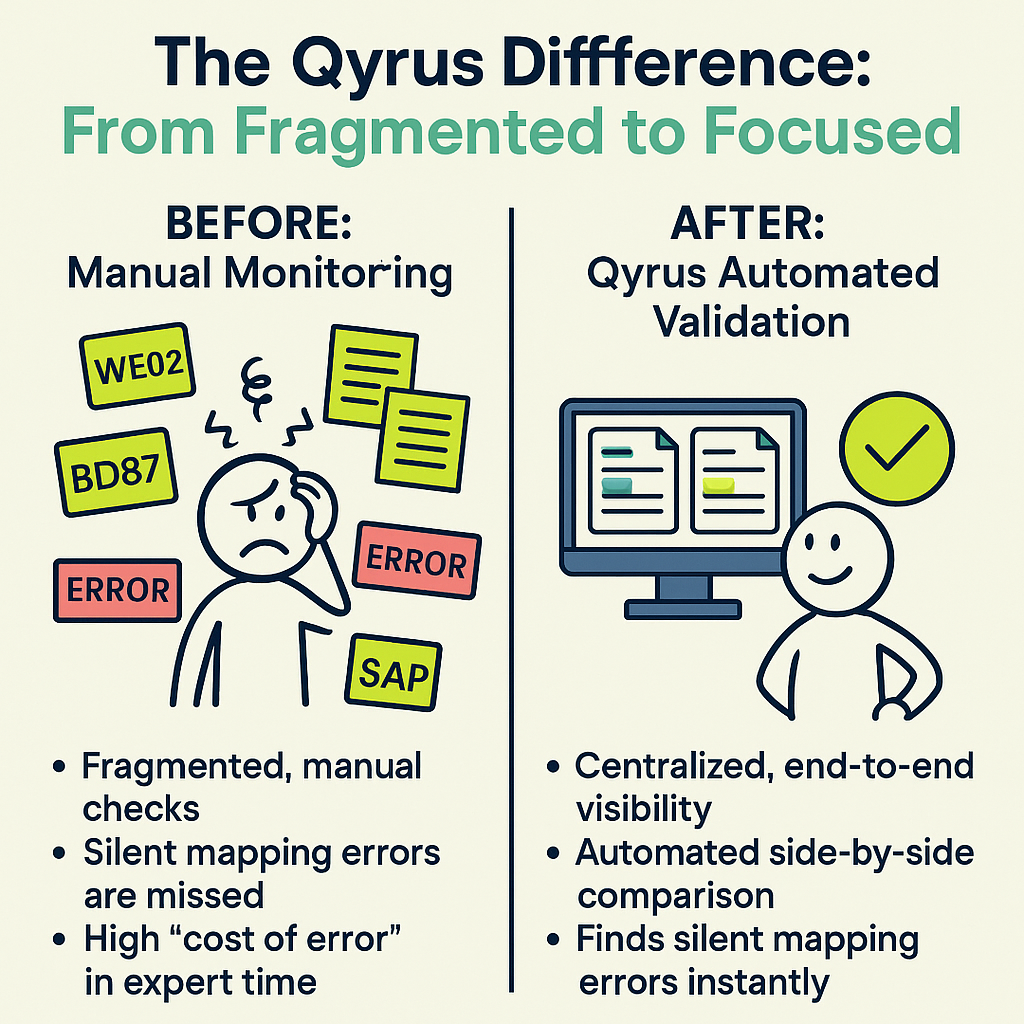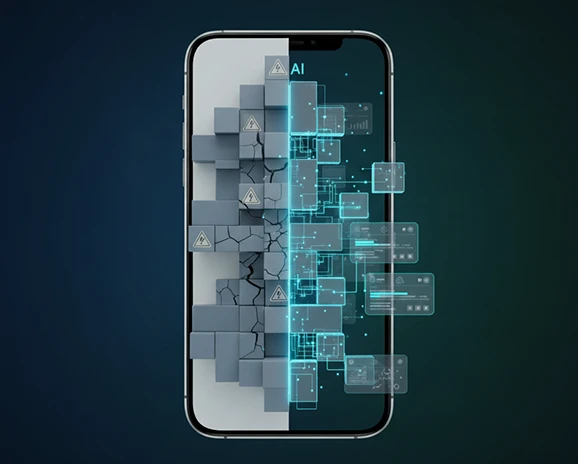Beyond the Green Light: Ensuring True Data Integrity in Your SAP EDI Processes


It’s a familiar feeling of relief for any SAP professional. You check the monitor, and there it is: Status 53. Application document posted. The SAP IDoc has finished its journey, the light is green, and everything appears to be a success. But is it? What if that green light is a lie, a digital facade hiding costly errors that are silently disrupting your operations and eroding your profits?
This isn’t a hypothetical fear; it’s a hidden reality in the high-stakes world of Electronic Data Interchange (EDI). EDI in SAP is the powerful, automated engine that exchanges critical business documents between trading partners, forming the very backbone of modern supply chains. It’s a massive and essential market, with research projecting its value to exceed $75 billion by 2033. Given that slightly more than half of all organizations rely on EDI to integrate solutions with their ERP systems, its smooth operation is non-negotiable.
Herein lies the dangerous blind spot. Your SAP system creates an IDoc, a standard data container, for the transaction. However, for your external partner to understand it, this SAP IDoc must first pass through a critical translation step. An intermediary piece of software, known as an EDI subsystem, must map and translate the IDoc into a global EDI standard like ANSI X12 or EDIFACT. This translation happens in a black box, outside of your SAP system’s direct view. A single flaw in that mapping logic can corrupt the data, even while SAP reports a successful handoff.
This post will pull back the curtain on this process. We will deconstruct the “cost of error” – a significant and often hidden component of your total cost of ownership – and reveal why a simple green light is not enough to guarantee data accuracy. It’s time to move beyond the illusion of success and find a way to achieve true data integrity.
The Anatomy of a Failure: Decoding the Cost of Error in Your SAP IDoc Landscape
To understand the “green light fallacy”, you first must understand the money it costs you. The largest, and most frequently underestimated component of an integration landscape’s Total Cost of Ownership (TCO) is not the software or the initial setup. It is the perpetual, operational “cost of error”. It’s the immense expense of manually monitoring and resolving the inevitable
SAP IDoc errors that arise in any high-volume environment. In fact, it is not uncommon for businesses to allocate a full-time, highly experienced, and therefore expensive, expert solely to the task of managing these failures.

The problem originates in a procedural black box. The journey of an outbound SAP IDoc doesn’t end when it’s created. Your SAP system’s direct responsibility concludes the moment it successfully passes the IDoc to the communication layer, known as the port (a milestone marked as Status ’03’). From there, a third-party EDI subsystem takes over, performing the complex and error-prone translation of the IDoc into a universal standard like ANSI X12. A single flaw in this external mapping can corrupt your data, long after SAP has washed its hands of the process.
These failures fall into a few distinct categories, but only one is truly silent.
- Data-Related Errors (Status 51): This is the most frequent inbound failure. The SAP IDoc is structured correctly, but the business data inside is invalid. Think of a purchase order arriving for a material master that doesn’t exist or for a customer who is on credit block. The system rightly stops and raises a red flag.
- Configuration Errors (Status 29): The process fails because the underlying setup within SAP is wrong. This is often due to a mistake in the Partner Profile (transaction WE20), the single most critical configuration object in the entire IDoc framework and a primary cause of routine processing failures.
- Silent Mapping Errors (The Real Villain): This is the most dangerous failure. It’s where the structure is valid, the configuration is correct, and the EDI in SAP process runs to completion. The SAP IDoc receives the coveted Status ’53’. However, due to a subtle flaw in the external translation mapping, the data is semantically wrong. The price might be off by a decimal point, the unit of measure might be wrong, or the shipping address could be incorrect. Your system displays a success, but you’ve just shipped the wrong goods or sent a faulty invoice, triggering costly disputes and chargebacks.
Illuminating the Black Box: How Qyrus Guards Your EDI in SAP
A reactive, “break-fix” approach to integration failures is unsustainable. The long-term solution isn’t to get better at firefighting; it’s to prevent the fires from starting by establishing proactive governance. The foundation of that strategy is true visibility. This means having the ability to see beyond individual SAP IDoc status codes and into the end-to-end health of your data flow. Standard SAP monitoring, fragmented across different transactions like WE02 and BD87, simply wasn’t built for this purpose.
This is where Qyrus Document Exchange Testing changes the game. Part of Qyrus SAP Testing solution, it’s a module designed specifically to provide the deep, end-to-end visibility that has been missing from EDI in SAP. It acts as your data integrity watchdog, moving you from a reactive state to a proactive one.
At its core, Qyrus’ “Relationship Spotter” feature solves a fundamental challenge. It automatically scans your SAP system to establish the crucial link between an incoming electronic document and the final business transaction it has posted. This creates a single, unified view of the entire process, a stark contrast to the siloed information available in standard tools.
Most importantly, Qyrus illuminates the black box of the EDI subsystem. It provides a clear window into the result of the complex translation process by enabling a side-by-side comparison of the source SAP IDoc and the final posted data. This allows you to audit the outcome of the mapping and verify that the data wasn’t corrupted during its journey. It is the definitive way to confirm that the unique requirements of each trading partner—a major challenge known as “partner heterogeneity”—were handled correctly, ensuring the data you sent is the data they actually received and posted.
Forensic-Level Detail: How Qyrus Puts Your Data Under the Microscope
So, how does Qyrus move beyond simply flagging a failed SAP IDoc to reveal the truth within your data? It provides a powerful, two-pronged approach that combines high-level oversight with a forensic deep-dive. It gives you both a telescope and a microscope.
It starts with the big picture. Qyrus allows you to perform a mass comparison of multiple IDocs at once, giving you a quick overview of any differences. This bulk analysis is the perfect tool for identifying systemic problems. You can instantly see if a whole batch of transactions from a specific partner is failing, or spot recurring patterns of errors that would be impossible to find by looking at IDocs one by one.
From this high-level view, you can then zoom in with laser-precision. The platform’s real power lies in its detailed, side-by-side comparison capabilities, which are designed to make finding discrepancies effortless.
- An Intuitive Split-Screen View: Qyrus presents the source SAP IDoc and the final posted business document in a visual, split-screen layout. This immediately removes the need to toggle between different screens or transactions to manually compare data points.
- Clear XML Tree Structure: Both the IDoc and its corresponding document are displayed in a clear, hierarchical XML tree structure. This is a massive advantage over viewing raw SAP IDoc data, as it allows you to easily compare not just field values but also the very structure of the documents.
- Automatic Difference Highlighting: You don’t have to hunt for errors. Qyrus automatically highlights every single difference between the two documents, from changes in segment order to modifications in field values. Your eyes are drawn directly to the problem areas, turning hours of tedious manual checking into seconds of instant recognition.
This combination of features provides the comprehensive analysis needed to not just see that an error occurred, but to understand precisely why it happened, enabling a faster, more accurate resolution.
The S/4HANA Proving Ground: Future-Proofing Your EDI in SAP
There’s a common misconception that the rise of SAP S/4HANA means the death of the SAP IDoc. Let’s be clear: for on-premise and private cloud editions of S/4HANA, this is simply not true. The IDoc framework remains a core, supported technology that is deeply embedded in standard B2B processes and is still perfectly reliable for its intended purpose. The future is one of coexistence, not extinction.
However, the migration to S/4HANA is a high-stakes proving ground for your integrations. This is where your data integrity is truly put to the test. Industry statistics paint a stark picture: a staggering 50-75% of ERP projects fail to meet their objectives, and 40% cause significant operational disruption after go-live. A primary reason for this is overlooked data and integration issues.
For any organization moving from ECC to S/4HANA, one of the most critical best practices is to use IDoc comparison tools to detect segment length changes and other structural differences to validate interfaces after the move. An SAP IDoc that worked perfectly in the old system can suddenly fail or, worse, post incorrectly in the new one. This makes a tool that can perform precise, automated comparisons between the source and target documents an absolute necessity for mitigating migration risk.
Looking beyond the migration, the strategic future of enterprise integration is a hybrid one. Your architecture will become a managed portfolio of patterns: robust, asynchronous EDI in SAP for high-volume B2B document exchange, running alongside modern, real-time APIs for cloud and mobile applications. Even in this evolved landscape, the need for data integrity on your core EDI transactions does not disappear. Qyrus provides that consistent, reliable validation layer, ensuring your most critical supply chain and financial processes continue to run flawlessly.
Beyond Tech: The Hard-Dollar ROI of Data Integrity
Ultimately, the case for better data validation isn’t just technical; it’s financial. Investing in a tool that provides true visibility into your EDI in SAP landscape delivers a powerful and quantifiable return by directly impacting your bottom line. The value isn’t just in finding errors; it’s in the costly consequences you avoid.
Industry research has consistently shown the immense benefits of a well-implemented EDI strategy, but these benefits are only realized when the data is correct.
- Dramatically Reduced Errors and Costs: Studies show that proper EDI implementation can reduce transaction errors by a staggering 30-40% and cut overall transaction costs by 35% or more. Qyrus is the enabling technology that ensures you achieve this, by catching the silent data errors that lead to expensive rework, chargebacks, and manual correction efforts.
- Accelerated Business Cycles: Flawless data flow means a faster business. Automated, accurate EDI in SAP has been shown to speed up order-to-cash cycles by approximately 20% and can shorten the entire order-to-shipment cycle by as much as 50-60%. When you eliminate the delays caused by data-related disputes, your entire supply chain becomes more agile.
- Mitigated Project Risk: By providing a robust validation framework for S/4HANA migrations and other projects, you directly de-risk these massive investments. A tool that helps you avoid becoming one of the 50-75% of ERP projects that fail to meet their objectives provides an ROI that is almost immeasurable.
- Freed-Up Expert Resources: Perhaps the most immediate return is reclaiming the valuable time of your most experienced personnel. Instead of dedicating expensive experts to the soul-crushing, manual task of firefighting SAP IDoc failures, you can empower them to focus on high-value innovation and strategic initiatives.
This is where true data integrity pays dividends—transforming EDI in SAP from a potential cost center riddled with hidden risks into a streamlined, efficient engine for business growth.

Stop Guessing, Start Knowing: The Future of Your Data Integrity
The green light of a Status 53 is an alluring, but ultimately incomplete, signal. It confirms that a process ran, not that it ran correctly. For years, organizations have operated with this critical blind spot, accepting the immense hidden costs of manual error correction as a necessary evil for doing business with EDI in SAP. The reality is that the most dangerous errors—the silent mapping flaws that corrupt your data without raising an alarm—are the ones that standard tools were never designed to catch.
Qyrus Document Exchange Testing provides the crucial missing layer of validation. It delivers the proactive, automated monitoring and deep, forensic-level comparison that experts recommend. By illuminating the black box of EDI translation and establishing a clear relationship between the source SAP IDoc and the final posted document replaces guesswork with certainty. It provides the checks and balances needed to manage the massive trail of transactions that define modern business.
Don’t let silent data errors and hidden costs dictate the efficiency of your operations. It’s time to move beyond the green light.
Schedule a personalized demo today to see firsthand how Qyrus can bring true, end-to-end data integrity to your business and ensure your SAP IDoc workflows are as successful as they appear.






